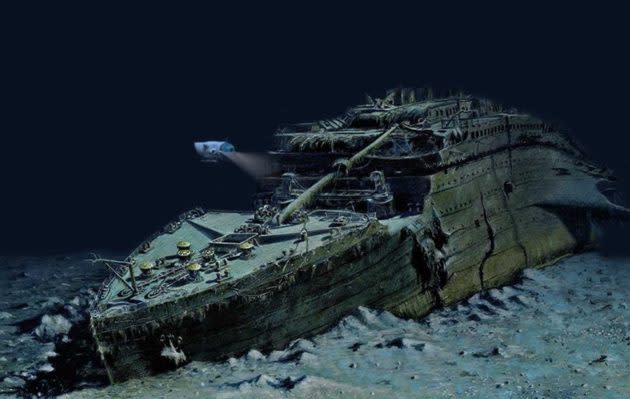OceanGate reveals plan to send scientists (and tourists) to Titanic shipwreck in 2018

OceanGate Expeditions says it’s planning the first crewed scientific expedition to study the wreck of the RMS Titanic in more than a decade.
The expedition team will use OceanGate’s state-of-the-art submersible, the Cyclops 2, and the latest in subsea imaging technology to assess the condition of the disintegrating shipwreck and document artifacts in the debris field.
OceanGate Expeditions is the exploration subsidiary of OceanGate Inc., based in Everett, Wash. The venture brings together explorers, scientists and filmmakers to document iconic shipwrecks, hydrothermal vents and other deep-sea curiosities.
Last year, OceanGate led an expedition to document the wreck of the Andrea Doria, an Italian ocean liner that sank more than 60 years ago off the Massachusetts coast.
Next year’s seven-week Titanic expedition, which is due to begin in May 2018, is envisioned as the first in a series of annual surveys of the Atlantic Ocean’s most famous shipwreck. It’ll be undertaken in collaboration with experts from the Advanced Imaging and Visualization Laboratory at the Woods Hole Oceanographic Institution in Massachusetts.
The Titanic sank in 1912 after running into an iceberg during its maiden voyage from England to New York. More than 1,500 of the ship’s 2,224 passengers and crew perished.
In 1985, a French-American team led by Robert Ballard rediscovered the wreck, marking the start of a series of undersea expeditions to the site. Hundreds of artifacts have been recovered, and scores of people have gotten close-up glimpses of the 12,800-foot-deep site during submersible tours.
Famed filmmaker James Cameron included shots of the Titanic in three movies: the Oscar-winning saga titled “Titanic”; and a pair of documentaries, “Ghosts of the Abyss” and “Last Mysteries of the Titanic.”
The last crewed scientific expedition to the site was in 2005, and remotely operated vehicles documented the state of the wreck in 2010. The last tourists visited during the 2012 centennial, at a cost of $59,000 a person.
“Since her sinking 105 years ago, fewer than 200 people have ever visited the wreck, far fewer than have flown to space or climbed Mount Everest, so this is an incredible opportunity to explore one of the most rarely seen and revered landmarks on the planet,” Stockton Rush, CEO of OceanGate Expeditions, said today in a news release announcing the upcoming expedition.
Scientists plan to capture images from OceanGate’s Cyclops 2 submersible, which is currently under construction, and process them to create a 3-D photographic model of the wreck.
OceanGate says nine individuals will join the crew as mission specialists, supporting the mission by helping to underwrite the expedition’s cost as well as assisting the team on site. Those slots are being sold through Blue Marble Private, a London-based luxury travel company. The Robb Report says the price for an eight-day tour is $105,129 (£86,500) per person.
OceanGate says the expedition will be conducted in accordance with preservation guidelines laid down by UNESCO and the National Oceanic and Atmospheric Administration. No artifacts will be collected.
“We recognize that the entire site is a memorial, and we undertake our mission with great respect for those who lost their lives in the sinking,” Rush said.
More from GeekWire:
OceanGate starts building submersible craft that can take crews 13,000 feet deep
OceanGate’s explorers map the Andrea Doria, the Mount Everest of shipwrecks
Amazon’s Jeff Bezos and Seattle’s Museum of Flight unwrap Apollo moon engine artifacts
GlobalXplorer launched: Now you can join the satellite hunt for lost cities in Peru